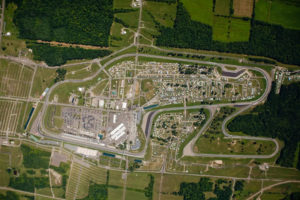Over the next 15 years the track hosted Formula 1, NASCAR, and sports car racing of every kind…
Watkins Glen International has one of the most fascinating histories of any race track in the northeast. Much like Road America in Elkhart Lake, Wisconsin, this upstate New York facility started life as a collection of public roads that had been joined together to form a circuit for motorsports competition.

The architect of the entire enterprise was Cameron Argetsinger, an Ohio transplant who had spent his summers in the area as a child. Eager for others to enjoy the same roads he had learned to drive on, and of course always on the look-out for a new venue in which to test the speed of his MG, Argetsinger drew up a 6.6-mile course that looped in and out of the town of Watkins Glen itself over both paved and gravel sections of road.
By working together with the SCCA, Argetsinger was able to get the town on his side (and convince the railroad company that owned the tracks they were crossing to shut down for a day). Thus was born the Watkins Glen Grand Prix, which ran 12 glorious laps for the first time in October of 1948.
In the early 1950s the organizers moved the event to a second set of country roads in roughly the same area. The temporary solution ran 4.6 miles and had a very different character, lacking much of the flow of the initial race course, and it wasn’t long before Argetsinger and his SCCA enablers began to explore leaving public roads behind and building the perfect, and permanent, home for the Grand Prix.
In 1956 the new track finally opened for business, a 2.3-mile setup on 550 acres of land within the familiar confines of Watkins Glen. Over the next 15 years the track hosted Formula 1, NASCAR, and sports car racing of every kind, quickly becoming the locus of motorsports not just in New York but along the East Coast.
The increased attention and use lead to a string of improvements and changes: the introduction of the ‘Boot’ in 1971 (that came with a number of other corner modifications and additions) was the most notable, as it lengthened the course to just under 3.4 miles in total. Additional configurations for the circuit continued to be refined over the ensuing years, and following a string of serious on-track incidents a pair of chicanes were added (one before the turn 4 back straight, and the other before the ‘Loop’).
There have been many memorable performances at Watkins Glen regardless of series, from AJ Allmendinger’s first NASCAR win after banging off Marcos Ambrose during the final two laps in 2014 to James Hunt’s dramatic win in 1976 that paved the way to his F1 championship (Hunt would win at WGI again the following year).
Despite the lack of a long main straight, the section of the track moving uphill from the first corner, through the esses, and onto the back straight allows drivers to gather a surprising amount of speed, making it one of the fastest courses in New England. That same momentum has to be bled off prior to entering the loop corner that leads downhill to the chute, where drivers are slowed momentarily by the sharpness of corner 7 (the toe) before making the climb up the boot straight that leads to the also-quick U-shaped sequence of corner 8, 9, and 10 that eventually leads back to the straight in front of the pits.
Watkins Glen International is one of most challenging and fun-to-drive stops on the COMSCC schedule. Incorporating technical corners with roller coaster elevation changes, it’s a thoroughly engaging race track that easily gets lodged in your brain after just a few laps.

